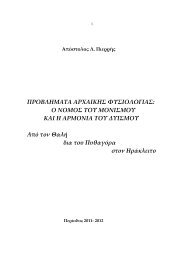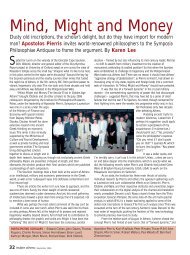APPENDIX C΄ ON DEPILATION: BODY COSMETICS IN CLASSICAL ...
APPENDIX C΄ ON DEPILATION: BODY COSMETICS IN CLASSICAL ...
APPENDIX C΄ ON DEPILATION: BODY COSMETICS IN CLASSICAL ...
You also want an ePaper? Increase the reach of your titles
YUMPU automatically turns print PDFs into web optimized ePapers that Google loves.
<strong>ON</strong> DEPILATI<strong>ON</strong>: <strong>BODY</strong> <strong>COSMETICS</strong> <strong>IN</strong> <strong>CLASSICAL</strong> ANTIQUITY 589<br />
prostitution in order that her friends, rather than the prostitutes,<br />
should enjoy ÙáÓ Ó¤ˆÓ Ùa˜ àÎÌ¿˜, the vigour of young men. And<br />
then she adds (721 sqq.): ηd Ù¿˜ Á ‰Ô‡Ï·˜ Ôé¯d ‰ÂÖ ÎÔÛÌÔ˘Ì¤Ó·˜ /<br />
ÙcÓ ÙáÓ âÏ¢ı¤ÚˆÓ ñÊ·Úapple¿˙ÂÈÓ K‡appleÚÈÓ, / àÏÏa apple·Úa ÙÔÖ˜ ‰Ô‡ÏÔÈÛÈ<br />
ÎÔÈÌÄÛı·È (this is an example of ÎÔÈÌÄÛı·È as signifying coition, if<br />
examples were needed) ÌfiÓÔÓ / ηوӿÎËÓ ÙeÓ ¯ÔÖÚÔÓ àappleÔÙÂÙÈÏ̤-<br />
Ó·˜. XÔÖÚÔ˜ is of course the pudendum muliebre. But how is ηوӿ-<br />
ÎËÓ to be construed? Mss. have ηوӿÎË and the vulgate ηو-<br />
Ó¿ÎFË, which Brunck tried to justify by interpreting it as ¯¿ÚÈÓ ÙáÓ<br />
‰Ô‡ÏˆÓ. K·ÙˆÓ¿ÎË was a coarse cloth worn by slaves, a kind of frock<br />
with a lower border of sheepskin (οو + Ó¿ÎÔ˜). V. Hesychius s.v.<br />
ηوӿÎË: îÌ¿ÙÈÔÓ ö¯ÔÓ âÎ ÙáÓ Î¿Ùˆ ÌÂÚáÓ Ó¿ÎÔ˜ appleÚÔÛÂÚ·Ì̤-<br />
ÓÔÓ, ¬ âÛÙÈ ÌËψً. (Cf. also Moeris s.v.). It is true that the Etym. M.<br />
expressly remarks p. 597.14, s.v. N¿ÎË: Ùe ·åÁÂÖÔÓ ‰¤ÚÌ·Ø Îˆ‰›· ηd<br />
ÎÒ‰ÈÔÓ, Ùe appleÚÔ‚¿ÙÈÔÓ. ÔéÎ ôÚ· Ùe âÓ KfiϯÔȘ, Ó¿ÎÔ˜ ÚËÙ¤ÔÓ. ηÎá˜<br />
ÔsÓ È̈ӛ‰Ë˜ Ó¿ÎÔ˜ ÊËÛ› (Fr. 39 (544) PMG Page). But this is at<br />
best ultra-purism. For Homer’s Odyssey ξ, 530: àÓ ‰b Ó¿ÎËÓ ≤ÏÂÙ’<br />
·åÁe˜ â¸ÙÚÂʤԘ ÌÂÁ¿ÏÔÈÔ cannot be taken to imply more than that<br />
Ó¿ÎË could be a goat-skin. The scholia have: Ó¿ÎËÓØ ‰¤ÚÌ· ·åÁe˜<br />
‰·Û‡Ì·ÏÏÔÓ which suggests that the scholiast would agree to the<br />
remark in the Etym. M. in which case we may trace the source of the<br />
exclusive view to Alexandrian false scientifism. What the Etymologus<br />
charges Simonides with, was committed by Lycophron, too; v.<br />
Alexandra, 1310; and before him Pindar Pythia IV, 68: apple¿Á¯Ú˘ÛÔÓ<br />
Ó¿ÎÔ˜ ÎÚÈÔÜ. Herodotus, as well, uses Ó¿ÎÔ˜ for sheepskin, even if not<br />
in connection with the Argonautic expedition (II, 42). Theocritus, on<br />
the other hand, uses the word for a goat-skin, Idyll V, 2 (cf. 9 and 11-<br />
12); the scholia to this passage are instructive: one explains the word in<br />
its present use, Ùɘ ·åÁe˜ Ùe ‰¤ÚÌ·; the other gives what was<br />
obviously taken from a lexicographic work: ÎÒ‰ÈÔÓ, n ÌËψÙcÓ<br />
ʷ̤Ó; and the last gives both meanings, with the information that<br />
Zenodotus probably insisted on the “sheepskin view”. This view we<br />
find in Photius (Ó¿ÎÔ˜Ø öÓÙÚȯÔÓ ‰¤ÚÌ· õÙÔÈ ‰ÔÚa appleÚÔ‚¿ÙÔ˘ - cf. also<br />
s.v. Ó·ÎÔÙ›ÏÙ·È). Suda has both interpretations, considering goatskin<br />
as the main one: Ó¿ÎÔ˜ öÓÙÚȯÔÓ ‰¤ÚÌ·, õÙÔÈ ‰ÔÚa appleÚÔ‚¿ÙÔ˘.<br />
K˘Ú›ˆ˜ ‰b Ùe Ùɘ ·åÁe˜ ‰¤ÚÌ·, Îá·˜ ‰b Ùe ÙÔÜ appleÚÔ‚¿ÙÔ˘.<br />
Hesychius explains as ÎÒ‰ÈÔÓ. ·úÁÂÈÔÓ ‰¤ÚÌ· ÌÂÙa ÙÚȯáÓØ thus also<br />
providing both interpretations, though again he has Ó·ÎÔÙ›ÏÙ·ÈØ Ôî










